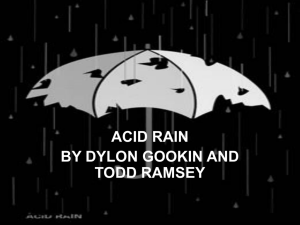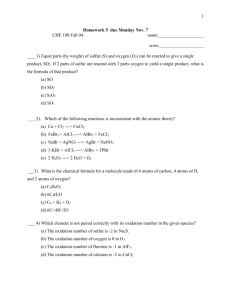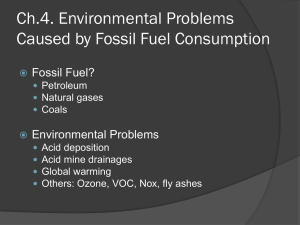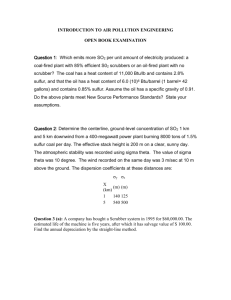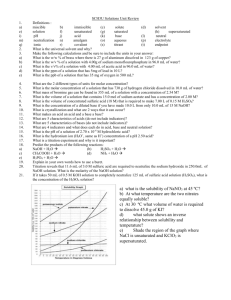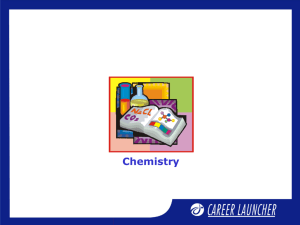15.p-Elements of VI A group.Oxygen and Sulfur
advertisement
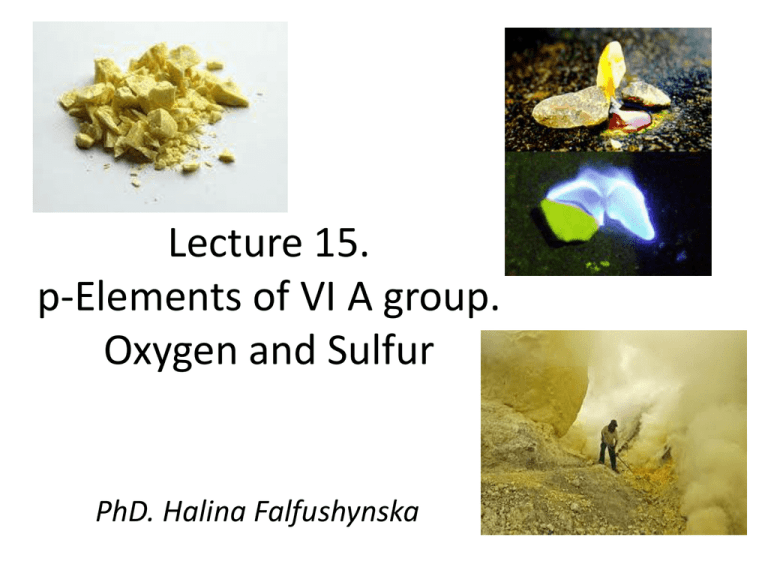
Lecture 15. p-Elements of VI A group. Oxygen and Sulfur PhD. Halina Falfushynska Preparation of Oxygen • In the laboratory, oxygen is prepared by several ways. • By heating oxygen containing salts such as chlorates, nitrates, bichromates and permanganates. KClO3→ 2KCl + 3O2 OF2 + 2NaOH O2 + 2NaF + H2O 2K2Cr2O7+ 8H2SO4 2K2SO4 +2Cr2(SO4)3 +3O2 +8H2O • By the thermal decomposition of the oxides of metals low in the electrochemical series and higher oxides of some metals 2 HgO 2 Hg + O2 ; PbO2 Pb + O2 ; 2Pb3O4(s) → 6PbO(s) + O2(g) Preparation of Oxygen • Hydrogen peroxide is readily decomposed into water and dioxygen by catalysts such as finely divided metals and manganese dioxide 2Н2О2 2Н2О + О2 • On large scale it can be prepared from water or air. Electrolysis of water leads to the release of hydrogen at the cathode and oxygen at the anode. Cathode: 4Н2О + 4е 2Н2 + 4ОН– Anode: 4ОН– – 4е О2 + 2Н2О • 2Na2O2 + 2CO2 2Na2CO3 + O2 Preparation of Oxygen Properties of Oxygen gas • Dioxygen is a colourless and odourless gas. • Its solubility in water is to the extent of 3.08 cm3 in 100 cm3 water at 293 K which is just sufficient for the vital support of marine and aquatic life. • It liquefies at 90 K and freezes at 55 K. It has three stable isotopes: 16O, 17O and 18O. • Molecular oxygen, O2 is unique in being paramagnetic inspite of having even number of electrons Reactivity towards non-metals Dioxygen directly reacts with nearly all non-metals except some noble gases. 2H2 + O2 2H2О N2 (g)+ O2 (g) (heat) 2NO (g) P4 + 5O2 (heat) 2P4O10 Reactivity towards metals Dioxygen directly reacts with nearly all metals except some of them (Au, Pt). 4Li + O2 2Li2O 2Na + O2 Na2O2 K + O2 KO2 Its combination with other elements is often strongly exothermic which helps in sustaining the reaction. However, to initiate the reaction, some external heating is required as bond dissociation enthalpy of oxgyen-oxygen double bond is high (493.4 kJ mol–1). A space-filling model of the water molecule. Catalytic Decomposition of Hydrogen Peroxide with MnO2 H2O2 is decomposed by catalytic amounts of manganese dioxide. Singlet oxygen is prepared by oxidation of hydrogen peroxide with NaOCl. Oxidation of Iron Iron is burned in pure oxygen to give Fe3O4. Combustion of a Cigar (cellulose) in pure Oxygen. A cigar soaked in liquid oxygen burns under strong evolution of heat. Redox Amphoteric Behaviour of Hydrogen Peroxide. H2O2 reacts in dependence of the reactant as oxidizing or as reducing agent. Test Reaction of Hydrogen Peroxide. H2O2 is identified by formation of an orange peroxocomplex of Ti(IV). Oxides Neutral N2O, CO Basic Simple MgO, Al2O3 Acidic Mixed Pb3O4, Fe3O4 Amphoteric metallic oxides non-metal oxides (N2O5) Some metallic oxides BaO oxides of some metals in Al2O3 high oxidation state Al2O3 + 6HCl + 9H2O → CaO + H2O (Mn2O7, CrO3, V2O5) 2 [Al(H2O)6]3+ + 6Cl→ Ca(OH)2 Al + 6NaOH + 3H2O → SO3 + H2O → H2SO4 2Na3[Al(OH)6] Ozone and its preparation • Ozone is an allotropic form of oxygen. It is too reactive to remain for long in the atmosphere at sea level. • At a height of about 20 kilometres, it is formed from atmospheric oxygen in the presence of sunlight. • Ozone layer protects the earth’s surface from an excessive concentration of ultraviolet (UV) radiations. Properties of Ozone • Ozone is thermodynamically unstable with respect to oxygen since its decomposition into oxygen results in the liberation of heat and an increase in entropy. • Ozone acts as a powerful oxidising agent Sulfur Rhombic sulfur (α-sulphur) 369 K The stable form at room temperature. It is insoluble in water but dissolves to some extent in benzene, alcohol and ether, CS2 Monoclinic sulfur (β-sulphur) It is soluble in CS2. At 369 K colourless needle shaped crystals of β-sulphur are formed. Both rhombic and monoclinic sulfur have S8 molecules. At elevated temperatures (~1000 K), S2 is the dominant species and is paramagnetic like O2. Extraction of sulfur by Frasch Method • As a mineral, native sulfur under salt domes is thought to be a fossil mineral resource, produced by the action of ancient bacteria on sulfate deposits. In this method, superheated water was pumped into a native sulfur deposit to melt the sulfur, and then compressed air returned the 99.5% pure melted product to the surface. Preparation of Sulphur • Sodium thiosulfate reacts with sulfuric acid Na2S2O3 + 2H2SO4 [H2S2O3] + 2NaHSO4 [H2S2O3] S + SO2 + H2O • SO2 + 2 H2S → 3 S + 2 H2O • 2H2S + O2 → 2H2O +2S • 16(NH4)HSO3 6(NH4)2SO4 + 4NH3 + 7SO2 + 3S + 10H2O (t=1500) • 2Na2S2O4 (Sodium dithionite) + H2O + HCl 3NaHSO3 + S + NaCl Reactivity towards metals Sulfur reacts with metals to form its binary compounds exhibiting –2 oxidation state, such as, CaS (calcium sulfide) Na2S (sodium sulfide). Fe + S → FeS + Q Cu + S → CuS + Q 16 Na + S8 → 8 Na2S Reactivity towards non-metals Sulfur reacts with non-metals to form its binary compounds exhibiting – 2, +4 and +6 oxidation states such as H2S (Hydrogen sulfide), SO2 (Sulphur dioxide), S2N2 (cyclic sulfur(II,IV) nitride). S + O2 SO2 + Q Н2 + S H2S S + 2Cl2 + 4NaF SF4 + 4NaCl Reactivity towards acids Sulfur reacts with acids S + 2H2SO4 3SO2 + 2H2O S + 6HNO3 H2SO4 + 6NO2 + 2H2O Reactivity towards alkalis Sulfur reacts with alkali 4S + 6NaOH Na2SO3S + 2Na2S + 3H2O (heat) Sulfur Dioxide • In the laboratory it is readily generated by treating a sulfite with dilute sulfuric acid. Na2SO3 + H2SO4 → Na2SO4 + H2O + SO2 SO32- (aq) + H+ (aq) → H2O(l) + SO2 (g) • Industrially, it is produced as a by-product of the roasting of sulfide ores. 4FeS2 + 11O2 → 2Fe2O3 + 8SO2 • C + 2H2SO4 → CO2 + 2SO2 + 2H2O • 4CaSO4 + 2C → 4CaO + 4SO2 + 2CO2 • 2H2S + 3O2 → 2H2O + 2SO2 Sulfur Dioxide properties • Sulphur dioxide, when passed through water, forms a solution of sulphurous acid. SO2 + H2O → H2SO3 • It reacts readily with sodium hydroxide solution, forming sodium sulphite . SO2 + 2NaOH → Na2SO3 + H2O • SO2 reacts with chlorine in the presence of charcoal (which acts as a catalyst) to give sulfuryl chloride. SO2(g) + Cl2 (g) → SO2Cl2(l) • When moist, SO2 behaves as a reducing agent. J2 + SO2 + H2O ® 2HJ + H2SO4 Sulfur trioxide preparation 2SO2 + O2 → 2SO3 • Sodium pyrosulfate decomposes, when sulfuric acid is present: Na2S2O7 (H+) → Na2SO4 + SO3 • Dehydration at 315°C and Cracking at 460°C: 2 NaHSO4 → Na2S2O7 + H2O; Na2S2O7 → Na2SO4 + SO3 Sulfur trioxide preparation Sulfur trioxide fuming in air Sulfur trioxide properties • SO3 is the anhydride of H2SO4: SO3 (l) + H2O (l) → H2SO4 (l) (−88 kJ mol−1) • At or above 340 °C, sulfuric acid, sulfur trioxide, and water coexist in significant equilibrium concentrations. • Sulfur trioxide also reacts with sulfur dichloride to yield the useful reagent, thionyl chloride. SO3 + SCl2 → SOCl2 + SO2 • SO3 is a strong Lewis acid readily forming crystalline complexes with pyridine, dioxane and trimethylamine which can be used as sulfonating agents. Oxoacids of Sulphur Oxoacids of Sulphur Manufacture of sulfuric acid by the Contact Process • (i) burning of sulphur or sulphide ores in air to generate SO2. • (ii) conversion of SO2 to SO3 by the reaction with oxygen in the presence of a catalyst (V2O5) • (iii) absorption of SO3 in H2SO4 to give Oleum (H2S2O7) • The key step in the manufacture of H2SO4 is the catalytic oxidation of SO2 with O2 to give SO3 in the presence of V2O5 (catalyst). Flow diagram for the manufacture of sulfuric acid by the Contact Process Properties of Sulfuric acid • In aqueous solution, sulphuric acid ionises in two steps. • The acid forms two series of salts: normal sulphates (CuSO4) and acid sulphates (NaHSO4). • Sulphuric acid, because of its low volatility can be used to manufacture more volatile acids from their corresponding salts. 2 MX + H2SO4 → 2 HX + M2SO4 (X = F, Cl, NO3) Sulfuric acids • Both metals and non-metals are oxidised by concentrated sulphuric acid, which is reduced to SO2. • 2 H2SO4 + 2 e- → SO2 + 2 H2O + SO42• 2Ag + 2H2SO4(conc) Ag2SO4 + SO2 + 2H2O • H2SO4(conc) + H2S S¯ + SO2 + 2H2O • 3H2SO4(conc) + 2KBr SO2 + Br2 + 2H2O + 2KHSO4 • 2H2SO4(conc) + C 2SO2 + CO2 + 2H2O • Cu + 2 H2SO4 → SO2 + 2 H2O + SO42- + Cu2+ Sulfuric acids • Dilute sulfuric acid reacts with metals via a single displacement reaction as with other typical acids, producing hydrogen gas and salts (the metal sulfate). It attacks reactive metals (metals at positions above copper in the reactivity series) such as Fe, Al, Zn,Mn, Mg and Ni. Fe (s) + H2SO4 (aq) → H2 (g) + FeSO4 (aq) • As shown above, the concentrated sulfuric acid is a strong oxidizing agent, especially when hot in which the acid itself carries out reduction whereas the dilute one acts a typical acid where the H+ is the oxidizing agent so the oxidizing property of it is not as powerful as the concentrated one. • Lead and tungsten, however, are resistant to sulfuric acid. Preparation of Metal Sulphides from the Elements. HgS, Cu2S, ZnS and Al2S3 are prepared by conversion of the metals with sulphur. Redox Reactions of the Sulphite Ion. Demonstration of Redoxamphotheric Behaviour of Sulphite Bleaching of a red rose with SO2. The reaction of the plant pigment with sulphur dioxide leads to a stable adduct. Decomposition of Thiosulphuric Acid. Sodium thiosulphate is decomposed in acidic solution.

